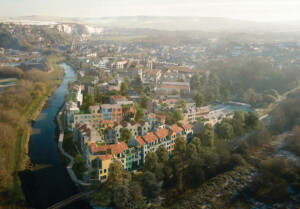Timber construction continues its march to mass market feasibility following a series of live blast tests on full-scale cross-laminated timber (CLT) structures. Through a series of tests conducted at the Tyndall Air Force Base in Florida, the WoodWorks Wood Products Council and U.S. Army are putting together guidelines for framing buildings with CLT.
As Engineering News–Record reports, the idea to test CLT for its blast resistance properties arose after developer and construction company Lendlease entered into an agreement to build hotels on army bases across the U.S. As Lendlease chose to frame some of their hotels with CLT to save on time and construction costs, they were told that CLT wasn’t explicitly mentioned in the Unified Facilities Criteria, the building code for the U.S. Army. This meant that the material would have to pass a battery of durability and security hardening-related tests before it could be applied in any real-world structures.
While the Army allowed the construction of Lendlease’s first CTL hotel, the Redstone Arsenal in Alabama, any future timber-framed buildings would require full-scale testing on a physical mockup before it could be approved. Lendlease reached out to WoodWorks Wood Products Council, who arranged the seven blast tests, Karagozian & Case Inc. (KCI), who developed and followed through on both phases of the testing, the Air Force Civil Engineer Center, and the University of Maine. The tests were carried out in two phases–the first in late 2016, and second at the end of last year.
Lendlease built the testing structures, each of which were exposed to successively larger blasts over a period of seven tests; two of the mock buildings were 27 feet tall with two-foot-tall parapets and window cutouts at 12 feet, and the third was 23 feet tall, with two-foot-tall parapets and window cutouts at 10 feet. Both “buildings” had 15-square-foot footprints.
After exposing the structures to 32 pounds, 67 pounds, and 199 pounds of TNT (with 610 pounds used for the last test), KCI concluded that for blast exposure, CLT was equivalent to the standard steel-studded wall. Because CLT panels contain multiple laminated layers, the remaining wood provides additional strength at the point of rupture. The load from the blast is also more evenly distributed owing to the panel’s support on all four sides, allowing the force to be evenly distributed towards the joints.
The U.S. Army Protective Design Center (PDC) has already released their report on the 2016 tests and will follow it up with their analysis of the second round of testing this June.











